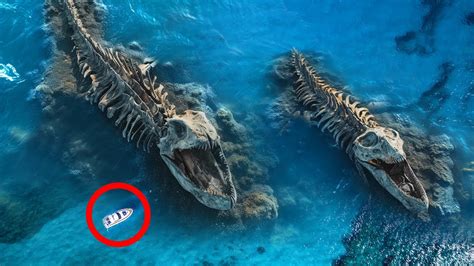
A creature believed to have vanished 200 million years ago has been filmed alive and well off the coast of Papua New Guinea, stunning scientists and reigniting debates about the resilience of ancient species and the mysteries of the deep ocean. The elusive animal, a type of nautilus, was captured on camera during a deep-sea exploration, offering a rare glimpse into a lineage that predates the dinosaurs.
The remarkable discovery, detailed by researchers involved in the expedition, provides crucial insights into the evolution, behavior, and survival strategies of these “living fossils.” While nautiluses are not entirely new to science, encountering one thought to be extinct for such a vast period is an extraordinary event, prompting further investigation into their habitat and the factors contributing to their continued existence.
The unexpected encounter occurred during an underwater exploration aimed at studying deep-sea ecosystems in the region. Equipped with advanced camera technology, the team documented the seafloor environment, capturing a variety of marine life. It was during this process that the nautilus, displaying distinct characteristics reminiscent of ancient species, was spotted gracefully navigating the ocean depths.
“This is more than just seeing a rare animal,” said Dr. Peter Ward, a renowned expert in nautilus biology and a lead researcher on the expedition. “It’s like seeing a ghost from the past. It rewrites what we know about survival and the possibilities of life on Earth.”
The footage obtained by the research team clearly shows the nautilus, with its characteristic coiled shell and numerous tentacles, moving through the water. Its presence in the area suggests that conditions conducive to its survival have persisted relatively unchanged for millions of years, providing a unique window into prehistoric marine environments.
The implications of this discovery extend beyond the realm of paleontology. Understanding how these ancient creatures have managed to survive while other species have succumbed to extinction can offer valuable lessons for conservation efforts in the face of modern environmental challenges.
Researchers are now planning further expeditions to the region to study the nautilus population in more detail. Their goals include assessing the size and distribution of the population, analyzing their genetic makeup, and investigating the specific environmental factors that have allowed them to persist for so long.
“We have a lot to learn from these living fossils,” explained Dr. Emily Carter, a marine biologist involved in the research. “They hold the key to understanding the long-term effects of environmental change and the potential for life to adapt and endure even in the most challenging conditions.”
The discovery of this ancient nautilus has not only captured the attention of the scientific community but also sparked public interest in the wonders of the natural world. It serves as a reminder of the vastness of the unknown and the importance of continued exploration and conservation efforts to protect the planet’s biodiversity.
Further Details and Background
Nautiluses are cephalopod mollusks, belonging to the same class as squids, octopuses, and cuttlefish. However, they are the only surviving members of a group that thrived hundreds of millions of years ago. Their distinctive feature is their coiled external shell, which is divided into chambers. The nautilus lives in the outermost chamber and uses the others for buoyancy control by regulating the amount of gas and liquid within them.
These creatures are primarily found in the Indo-Pacific region, inhabiting deep-sea environments ranging from 300 to 2,000 feet below the surface. They are nocturnal predators, feeding on crustaceans, small fish, and carrion. Nautiluses are known for their slow growth rates and long lifespans, with some individuals living for over 100 years.
The fossil record indicates that nautiluses were much more diverse and abundant in the past. Their lineage can be traced back over 500 million years, to the early Paleozoic era. During this time, they were a dominant group of marine predators. However, as other cephalopods evolved, particularly those with internal shells and more advanced swimming capabilities, nautiluses gradually declined in diversity and abundance.
The discovery of a nautilus species believed to have been extinct for 200 million years challenges the conventional understanding of evolutionary timelines. It raises questions about the factors that can contribute to the survival of ancient species and the role of environmental stability in preserving biodiversity.
One possible explanation for the nautilus’s continued existence is its ability to adapt to deep-sea environments. These environments are often characterized by stable temperatures, low light levels, and limited food resources. Species that can tolerate these conditions may be able to persist for long periods of time, even as surface environments undergo dramatic changes.
Another factor may be the nautilus’s relatively simple lifestyle. Unlike more advanced cephalopods, they do not rely on complex hunting strategies or social behaviors. Their slow metabolism and low energy requirements may allow them to survive in areas where other species struggle to find enough food.
The discovery also highlights the importance of continued exploration of the deep ocean. This vast and largely unexplored environment is home to a wealth of biodiversity, including many species that are still unknown to science. By studying these ecosystems, researchers can gain valuable insights into the evolution and ecology of marine life and the potential for discovering new resources and technologies.
Conservation Concerns
Despite their long history of survival, nautiluses face a number of threats in the modern world. Overfishing is a major concern, as they are often caught as bycatch in fisheries targeting other species. Their shells are also highly prized by collectors, leading to unsustainable harvesting in some areas.
In addition, nautiluses are vulnerable to habitat destruction and pollution. Coastal development, dredging, and mining can disrupt their deep-sea habitats, while pollution from land-based sources can contaminate their food supply. Climate change is also a growing threat, as rising ocean temperatures and acidification can affect their physiology and reproduction.
Recognizing these threats, conservation organizations and governments have taken steps to protect nautiluses. Some countries have banned or restricted the harvesting of nautiluses, while others have established marine protected areas to safeguard their habitats. International trade in nautilus shells is also regulated under the Convention on International Trade in Endangered Species (CITES).
However, more needs to be done to ensure the long-term survival of these ancient creatures. This includes reducing fishing pressure, controlling pollution, mitigating climate change, and promoting sustainable tourism. By working together, scientists, policymakers, and the public can help to protect nautiluses and preserve their unique place in the history of life on Earth.
The recent discovery serves as a powerful reminder of the fragility of biodiversity and the importance of conservation efforts. It underscores the need for a greater understanding of the deep ocean and the species that inhabit it, as well as a commitment to protecting these ecosystems for future generations.
Implications for Evolutionary Biology
The resurgence of a creature thought extinct for 200 million years presents a unique opportunity to re-evaluate established evolutionary timelines and theories. The nautilus’s survival challenges conventional notions of extinction and raises fundamental questions about the mechanisms that allow certain species to persist through vast geological epochs while others perish.
This discovery highlights the phenomenon of “Lazarus taxa,” which refers to species that disappear from the fossil record only to reappear later. These species provide valuable insights into the factors that contribute to evolutionary resilience and the potential for long-term survival in the face of environmental change.
The nautilus’s case is particularly remarkable due to the immense timescale involved. Its apparent survival for 200 million years suggests that its lineage has remained relatively unchanged during a period of significant evolutionary turnover in other groups of organisms. This raises questions about the selective pressures that have shaped its evolution and the genetic mechanisms that have allowed it to maintain its ancient characteristics.
Researchers are now conducting genetic analyses of the rediscovered nautilus to compare its DNA with that of other nautilus species and with fossil specimens. This will help to determine its precise evolutionary relationships and to identify any unique genetic adaptations that may have contributed to its survival.
The findings from these studies could have significant implications for understanding the evolution of other species as well. By identifying the genetic and ecological factors that have allowed the nautilus to persist for so long, researchers may be able to gain insights into the mechanisms that promote evolutionary resilience in other organisms.
This knowledge could be particularly valuable in the context of modern environmental challenges. As climate change, habitat destruction, and pollution threaten biodiversity around the world, understanding the factors that allow species to adapt and survive is becoming increasingly important.
The nautilus’s story serves as a testament to the power of adaptation and the enduring potential of life on Earth. It is a reminder that the fossil record is incomplete and that there are still many mysteries to be uncovered in the natural world. By continuing to explore and study these ancient creatures, researchers can gain a deeper understanding of the history of life and the challenges and opportunities that lie ahead.
The Role of Deep-Sea Exploration
The discovery of the ancient nautilus underscores the critical importance of deep-sea exploration. The deep ocean, which covers over 60% of the Earth’s surface, remains one of the least explored environments on the planet. It is home to a vast array of unique and often bizarre creatures, many of which are still unknown to science.
Deep-sea exploration is challenging and expensive, requiring specialized equipment and expertise. However, the potential rewards are enormous. By studying deep-sea ecosystems, researchers can gain valuable insights into the evolution and ecology of marine life, the functioning of the planet’s climate system, and the potential for discovering new resources and technologies.
The technology used to explore the deep ocean has advanced rapidly in recent years. Remotely operated vehicles (ROVs) and autonomous underwater vehicles (AUVs) can now be deployed to depths of thousands of meters, allowing researchers to collect data and samples from previously inaccessible areas.
These technologies were instrumental in the discovery of the ancient nautilus. The research team used ROVs equipped with high-definition cameras to survey the seafloor in Papua New Guinea. It was during one of these surveys that the nautilus was spotted, providing the first evidence of its continued existence.
The discovery highlights the potential for further discoveries in the deep ocean. As exploration efforts expand and technology improves, it is likely that many more new species and ecosystems will be found. These discoveries could have profound implications for our understanding of the natural world and the challenges and opportunities that lie ahead.
In addition to its scientific value, deep-sea exploration also has potential economic benefits. The deep ocean is home to a variety of valuable resources, including minerals, oil, and gas. As land-based resources become depleted, there is growing interest in exploiting these deep-sea resources.
However, deep-sea mining and other forms of resource extraction also pose significant environmental risks. These activities can disrupt deep-sea ecosystems, damage sensitive habitats, and release pollutants into the water column. It is therefore essential that any exploitation of deep-sea resources is carried out in a sustainable and responsible manner, with careful consideration of the potential environmental impacts.
Deep-sea exploration is a complex and multifaceted endeavor, requiring collaboration between scientists, engineers, policymakers, and the public. By working together, we can ensure that the deep ocean is explored and managed in a way that benefits both humanity and the environment. The tale of the resurfaced nautilus serves as a compelling call for continued investment in this critical area of research.
The Broader Significance
The rediscovery of this nautilus species, thought to have been extinct for 200 million years, resonates far beyond the scientific community. It touches upon fundamental questions about life, resilience, and the interconnectedness of ecosystems across geological time.
This event reignites public fascination with the natural world, reminding us that mysteries still abound, and that our planet holds secrets waiting to be uncovered. It underscores the importance of exploration, not just in the physical realm, but also in the realms of scientific inquiry and technological innovation.
The nautilus’s story also serves as a powerful symbol of hope in the face of environmental challenges. Its survival for so long suggests that life can adapt and endure even in the most extreme conditions. This message is particularly relevant in the context of climate change, habitat destruction, and other threats to biodiversity.
By learning from the nautilus and other “living fossils,” we can gain valuable insights into the factors that promote evolutionary resilience. This knowledge can inform conservation efforts and help us to protect the planet’s biodiversity for future generations.
The rediscovery also highlights the importance of international cooperation in addressing global environmental challenges. The research team that discovered the nautilus was comprised of scientists from multiple countries, working together to explore and study the deep ocean. This collaborative approach is essential for addressing complex issues such as climate change and biodiversity loss.
Ultimately, the story of the ancient nautilus is a reminder of our shared responsibility to protect the planet and its inhabitants. By working together, we can ensure that future generations have the opportunity to marvel at the wonders of the natural world and to learn from the lessons of the past. The nautilus stands as a testament to the enduring power of life and a call to action to safeguard its future.
Frequently Asked Questions (FAQ)
1. What exactly was discovered in Papua New Guinea?
A nautilus species, a type of cephalopod mollusk with a coiled shell, believed to have been extinct for approximately 200 million years, was filmed alive and well off the coast of Papua New Guinea. This is considered a significant discovery as it challenges previous assumptions about the survival and extinction of ancient species.
2. Why is the rediscovery of this nautilus so significant to scientists?
The rediscovery is significant for several reasons:
- Rewrites Evolutionary Timelines: It challenges the conventional understanding of extinction, indicating that some species can persist much longer than previously thought.
- Insights into Survival: It provides an opportunity to study the factors that allowed this species to survive for millions of years, offering valuable lessons for conservation efforts.
- Understanding Ancient Environments: The nautilus can provide a window into prehistoric marine environments and the conditions that supported its existence.
- Genetic Research: Analyzing the nautilus’s DNA can reveal unique adaptations that contributed to its survival.
3. What are the main threats facing nautiluses today?
Despite their long history of survival, nautiluses face several modern threats:
- Overfishing: They are often caught as bycatch in fisheries targeting other species.
- Shell Harvesting: Their shells are highly prized by collectors, leading to unsustainable harvesting.
- Habitat Destruction: Coastal development, dredging, and mining can disrupt their deep-sea habitats.
- Pollution: Pollution from land-based sources can contaminate their food supply.
- Climate Change: Rising ocean temperatures and acidification can affect their physiology and reproduction.
4. What measures are being taken to protect nautiluses?
Various measures are being implemented to protect nautiluses:
- Fishing Restrictions: Some countries have banned or restricted the harvesting of nautiluses.
- Marine Protected Areas: Establishing protected areas to safeguard their habitats.
- International Trade Regulations: International trade in nautilus shells is regulated under CITES (Convention on International Trade in Endangered Species).
- Conservation Efforts: Organizations are working to reduce fishing pressure, control pollution, and mitigate climate change.
5. What are the implications of this discovery for deep-sea exploration?
The discovery underscores the importance of deep-sea exploration because:
- Unexplored Biodiversity: The deep ocean remains largely unexplored and is home to a vast array of unique species.
- Potential for Discoveries: It highlights the potential for further discoveries in the deep ocean, with the likelihood of finding more new species and ecosystems.
- Technological Advancements: The use of ROVs and AUVs enables researchers to access previously inaccessible areas, facilitating new discoveries.
- Resource Management: Deep-sea exploration can inform the sustainable management of deep-sea resources while minimizing environmental impacts.









